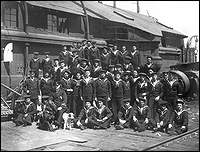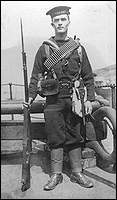|


|

|

Royal Naval Reserve
At the turn of the twentieth century, concerns about naval rivalry inspired efforts to strengthen
Britain’s naval resources. Newfoundland was no exception. In 1902, the government authorized the
establishment of a 600-man Royal Naval Reserve. In October of the same year, the British Admiralty
assigned the HMS Calypso as a ship to train the members of the reserve.
The HMS Calypso, n.d.
The training ship for the Royal Naval Reserve, 1902–1922. It
was renamed the HMS Briton in 1916.
Courtesy of the Provincial Archives of Newfoundland and Labrador (PANL B-17-22), St. John’s,
Newfoundland.
 (27 Kb)
(27 Kb)
|
 |

|
The government paid the expenses of Naval Reservists from the outports who travelled to and
from St. John’s for training. Enlistees trained in St. John’s for 28 days and remained
available for service for five years.
On August 2, 1914, as concerns heightened about a European war, reservists were called to
active duty. Commander A. MacDermott expected problems with the call-up, as it was the
height of the fishing season, but his fears were unfounded. MacDermott reported that once the call was issued
“every man-jack of them (responded) and with no trouble at all, though many of them had to walk fifty or sixty miles to the
nearest steamer or railway station” (MacDermott 436).

|
 |
Royal Naval Reservists from the HMS Calypso, n.d.
Courtesy of the Provincial Archives of Newfoundland and Labrador (PANL NA-1529), St. John’s,
Newfoundland.
 (49 Kb)
(49 Kb)
|
Unlike the men of the First Newfoundland Regiment, who remained with their unit, the members
of the Naval Reserve were dispersed throughout the Royal Navy. MacDermott recounted that
Newfoundland’s sailors “were scattered throughout every flotilla and squadron in the war zone, and
earned high praise from their commanding officers everywhere”( MacDermott 436). The transition to military life proved an
easy one for the reservists. “Newfoundlanders took to naval life and routine like ducks to water . . . Their
conduct was exemplary, punishments were practically unknown, and every order was carried out with
cheerful alacrity and seamanlike intelligence . . . I may say, indeed, that there were no smarter-looking
men in the whole Service” (MacDermott 436).
Postcard of a Royal Naval Reservist in complete uniform, HMS Briton, ca. 1916.
Courtesy of the Provincial Archives of Newfoundland and Labrador (PANL VA-58-21), St. John’s,
Newfoundland.
 (29 Kb)
(29 Kb)
|
 |

|
In addition to their service overseas with the Royal Navy, members of the reserve also served at
home, forming a protective guard at the Admiralty wireless station in Mount Pearl and manning a 12-pounder gun at
Fort Waldegrave to protect the entrance to St. John’s Harbour.
By the end of the war, 1,964 reservists had served. There were 180 fatalities. Sir
Winston Churchill later described Newfoundlanders as “the best small boat men in the world” (Rowe 374–375). The Royal
Naval Reserve disbanded in 1920–21.
Updated September, 2004

|

|
 |